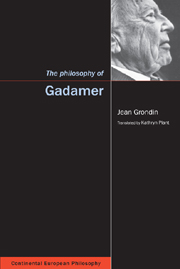Book contents
- Frontmatter
- Contents
- Abbreviations
- Translator's Note
- Introduction
- 1 The Problem of Method and the Project of a Hermeneutics of the Human Sciences
- 2 Truth after Art
- 3 The Destruction of Prejudices in Nineteenth-Century Aesthetics and Epistemology
- 4 Vigilance and Horizon in Hermeneutics
- 5 The Dialogue that We Are
- Conclusion
- Notes
- Bibliography
- Index
4 - Vigilance and Horizon in Hermeneutics
- Frontmatter
- Contents
- Abbreviations
- Translator's Note
- Introduction
- 1 The Problem of Method and the Project of a Hermeneutics of the Human Sciences
- 2 Truth after Art
- 3 The Destruction of Prejudices in Nineteenth-Century Aesthetics and Epistemology
- 4 Vigilance and Horizon in Hermeneutics
- 5 The Dialogue that We Are
- Conclusion
- Notes
- Bibliography
- Index
Summary
The constellation of understanding
The main point of the hermeneutics of facticity and its contrast with the transcendental constitution research of Husserl's phenomenology was that no freely chosen relation toward one's own being can get behind the facticity of this being. Everything that makes possible and limits Dasein's projection ineluctably precedes it. This existential structure of Dasein must also leave its trace in the understanding of historical tradition, which is why we initially follow Heidegger.
As he starts with Heidegger and Being and Time, Gadamer also starts with the circle of understanding. To the circle of understanding Heidegger gave an ontological, non-epistemological direction, because Dasein is an object of care and its future forms the priority of care, which he understands as the function of more or less implicit anticipations. Through these anticipations of meaning, he tries in a way to ward off attacks, knowing that existence itself will still reserve some for him, up to the unanswerable blow, death, which all the dispositions of metaphysics seek to escape.
The reason is that there is no understanding without anticipation, no interpretation without prior understanding, which the circle raises from Dasein's mode of being. But already Heidegger does not like to speak of “circle”, as the imagery is spatial, or more precisely geometric. In Heidegger's terminology, it is of an image modelled on subsisting being, and therefore misplaced in the unquiet flexibility of Dasein.
- Type
- Chapter
- Information
- The Philosophy of Gadamer , pp. 79 - 122Publisher: Acumen PublishingPrint publication year: 2002



